M
I
C
R
O
S
T
O
R
Y
O
F
A
R
T
........................................................

NOW COMPLETED:

........................................................
MICROSTORY OF ART
ONLINE JOURNAL FOR ART, CONNOISSEURSHIP
AND CULTURAL JOURNALISM
........................................................
INDEX | PINBOARD | MICROSTORIES |
FEATURES | SPECIAL EDITIONS |
HISTORY AND THEORY OF ATTRIBUTION |
ETHNOGRAPHY OF CONNOISSEURSHIP |
SEARCH

........................................................



 >MICROSTORIES
>MICROSTORIES
- Richard Serra
- Martin Scorsese
- Claude Simon
- Sunshine
- Werner Herzog
- The Creation
- Marcel Duchamp
- Nino Rota
- Wölfflin and Woolf
- Hansjörg Schneider
- Kraftort Arkadien
- Visual Biography
- Schlaraffenleben
- Die Geisteswissenschaften
- The Voyeur
- Buzzword Sustainability
- Paul Verlaine
- Tao Yuanming
- New Beginning
- Seneca
- Still Lifes
- Charles Baudelaire
- Frédéric Chopin
- The Art History of Sustainability
- Wang Wei
- Solarpunk
- Historians of Light
- Lepanto
- Renaturalization
- Plates
- Snow in Provence
- Learning to See
- Picasso Dictionaries
- Peach Blossom Spring
- Picasso Tourism
- Tipping Points
- Sviatoslav Richter
- Weather Reports
- Treasure Hunt
- Another Snowscape in Picasso
- Picasso in 2023
- Dragon Veins
- The Gloomy Day
- The Art of the Pentimento
- Reforestation
- The Status of Painting
- Emergency Supply
- Punctuality
- Watching Traffic
- Zhong Kui
- How Painting Survived the 1990s
- Confirmation Bias
- Sustainability and Luxury
- Garage Bands
- Picasso and Artificial Intelligence
- Eyes of Tomorrow
- Picasso in 2023 2
- Gluing Oneself to Something
- Suburbia
- Bamboo
- Sustainability and Carpe Diem 1
- Interviews with Bruegel
- Sustainability and Carpe Diem 2
- Coffee & Sugar
- Bamboo 2
- Picasso in 2023 3
- Sustainability and Carpe Diem 3
- Cherry Orchard
- Old Magazines
- Chance
- Nick Drake
- Harlequin
- The Smartphone & the Art Book
- Atlas Syndrome
- The Kitchen
- Atlas Syndrome 2
- Consideration
- Tori Amos
- School
- Orchard Auctioning Day
- The Hundred Years’ War
- Sócrates
- Chameleon
- Nefertiti Bust
- Picasso as a Computer
- Sunflowers
- Philemon & Baucis
- Ode to the Radio
- Childhood
- Wimmelbild
- Restitution
- Nick Drake 2
- Wishful Thinking
- Sundays
- The Independent Scholar
- September
- The Fisherman by Pirosmani
- Microadventure
- Sociology
- Salvator Mundi
- Chillon
- Appassionata
- Amber
- Homer
- Berlin
- Planet Walk
- Improvisation
- Seeing Picasso
- These Nice Kids
- Robber
- The One
- The Sea Turtle
- Zoo
- Through the Hush
- Wunderkammer
- I Do Not Seek, I Find
- Shopping Mall
- Food Hamper
- The Secretary
- This Gate
- Nor Rainy Day
- House on a Hill
- Beautiful Island
- Second-hand Bookstore
- Flat
- Slap in the Face
- Serra, Wenkenpark
- Apologies
- The Bells
- Nordmann Fir
- Picasso Wanting To Be Poor
- Picasso, Pirosmani
- A Brief History of Sculpture
- 24 Sunsets
- Rusty Phoenix
- Glove
- Wintry Stanza
- A Song
- Like A Beatle
- Catching An Orange
- Solar Bees
- Permaculture

 >FEATURES
>FEATURES
- Van Gogh On Connoisseurship
- Two Museum’s Men
- Ende Pintrix and the City in Flames
- Titian, Leonardo and the Blue Hour
- The Man with the Golden Helmet: a documentation
- Un Jury d’admission à l’expertise
- Learning to See in Hitler’s Munich
- Leonardo da Vinci and Switzerland
- The Blue Hour Continued
- The Blue Hour in Louis Malle
- Kafka in the Blue Hour
- Blue Matisse
- Blue Hours of Hamburg and LA
- A Brief History of the Cranberry
- The Other Liberale in the House
- The Blue Hour in Raphael
- Who Did Invent the Blue Hour?
- Monet on Sustainability
- Velázquez and Sustainability
- The Blue Hour in Guillaume Apollinaire
- Van Gogh on Sustainability
- The Blue Hour in Marcel Proust
- Picasso and Sustainability
- The Contemporary Blue Hour
- The Blue Hour in 1492
- The Blue Hour in Hopper and Rothko
- Hopper and Sustainability
- The Blue Hour in Ecotopia
- The Hour Blue in Joan Mitchell
- Explaining the Twilight
- The Twilight of Thaw
- The Blue Hour in Pierre Bonnard
- Explaining the Twilight 2
- Picasso on Stalin
- Rubens on Sustainability
- The Salvator Mundi in Bruegel and Rubens
- The Blue Hour in Leonardo da Vinci and Poussin
- The Blue Hour in Rimbaud
- Faking the Dawn
- Frost and Thaw in Ilya Ehrenburg
- Picasso, Stalin, Beria
- Picasso, Solzhenitsyn and the Gulag
- Shostakovich on Picasso
- Hélène Parmelin in 1956
- Historians of Picasso Blue
- Picasso Travelling to Moscow 1
- The Blue Hour in Caravaggio
- Picasso Travelling to Moscow 2
- Picasso, the Knife Game and the Unsettling in Art
- Some Notes on Leonardo da Vinci and Slavery
- Picasso Moving to the Swiss Goldcoast
- The Blue Hour in Camus
- The Blue Hour in Symbolism and Surrealism
- Caspar David Friedrich in His Element
- Exhibiting the Northern Light
- Caspar David Friedrich in His Element 2
- Robert Schumann and the History of the Nocturne
- The Blue Hour in Robert Schumann
- Caspar David Friedrich and Sustainability
- The Twilight of Thaw 2
- Multicultural Twilight
- The Blue Hour in Anton Chekhov
- The Blue Hour in Medieval Art
- Twilight Photography
- The Blue Hour in Bob Dylan
- Iconography of Optimism

 >SPECIAL EDITIONS
>SPECIAL EDITIONS
- Visions of Cosmopolis
- Mona Lisa Landscapes
- Turner and Ruskin at Rheinfelden
- Painters On TV & On TV
- Spazzacamini in Art
- A Last Glance at Le Jardin de Daubigny
- The Experimental Cicerone
- A Dictionary of Imaginary Art Historical Works
- Iconography of Blogging
- Begegnung auf dem Münsterplatz
- Cecom
- Das Projekt Visual Apprenticeship
- Those Who See More
- A Fox on Seeing with the Heart
- Sammlung Werner Weisbach
- Daubigny Revisited
- Some Salvator Mundi Microstories
- Some Salvator Mundi Afterthougths
- Some Salvator Mundi Variations
- Some Salvator Mundi Revisions
- A Salvator Mundi Questionnaire
- A Salvator Mundi Puzzle
- Unknown Melzi
- Francis I and the Crown of Charlemagne
- From Amboise to Fontainebleau
- Drones Above Chambord
- Looking Back At Conques
- Flaubert At Fontainebleau
- Images of Imperial Ideology
- The Chronicles of Santa Maria delle Grazie
- Seeing Right Through Someone
- Melzi the Secretary
- Eying Glass
- A Foil to the Mona Lisa
- A Renaissance of the Cartoon
- Sketching a Family Tree
- Venetian Variations
- A Brief History of Digital Restoring
- A Consortium of Painters
- Leonardeschi and Landscape
- A Christ in Profile
- Learning to See in Spanish Milan
- A History of Gestures
- Leonardo and Josquin
- A Renaissance of the Hybrid
- Suida and Heydenreich
- The Watershed
- Three Veils
- From Beginning to End
- Connoisseurship of AI
- Twilight and Enlightenment
- The Blue Hour in Chinese Painting
- Dusk and Dawn at La Californie
- Iconography of Sustainability
- The Blue Hour in Goethe and Stendhal
- The Sky in Verlaine
- The Blue Hour in Paul Klee
- Iconography of Sustainability 2
- The Blue Hour in Charles Baudelaire
- From Bruegel to Solarpunk
- Some Salvator Mundi Documentaries
- Some More Salvator Mundi Monkey Business
- The Windsor Sleeve
- Brigitte Bardot’s Encounter with Picasso
- Art Historians and Historians
- A Salvator Mundi Chronicle
- The Salvator Mundi and the French Revolution
- The Fontainebleau Group
- The Encounter of Harry Truman with Pablo Picasso
- The Fontainebleau Group Continued
- The Windsor Sleeve Continued
- The Salvator Mundi in Early Netherlandish Painting 1
- Some Salvator Mundi Resources
- A New Salvator Mundi Questionnaire
- The Woman in Picasso
- The Yarborough Group
- Melzi, Figino and the Mona Lisa
- The Yarborough Group Continued
- A Salvator Mundi Global History
- The Salvator Mundi in Medieval Art
- The Salvator Mundi in Medieval Art 2
- The Salvator Mundi in Early Netherlandish Painting 2


 >HISTORY AND THEORY OF ATTRIBUTION
>HISTORY AND THEORY OF ATTRIBUTION
- The Mysterious »Donna Laura Minghetti-Leonardo«
- Assorted Demons of Connoisseurship
- Panofsky Meets Morelli
- Discovering the Eye of Sherlock Holmes
- Handling the Left-handed Hatchings Argument
- Visual History of Connoisseurship
- Alexander Perrig
- Connoisseurship in 2666
- What Postmodernity Has Done to Connoisseurship
- Dividing Four Fab Hands
- A Leonardesque Ambassador
- Test Cases in Connoisseurship
- A Raphael Expertise
- How to Tell Titian from Giorgione
- Louise Richter
- The Unique Property in the History of Connoisseurship
- An Expertise by Berenson
- The Book of Expertises
- An Album of Expertises
- An Expertise by Friedländer
- A Salvator Mundi Provenance
- How to Tell Leonardo from Luini
- An Expertise by Crowe and Cavalcaselle
- An Expertise by Bayersdorfer
- An Expertise by Hermann Voss
- An Expertise by Hofstede de Groot
- Leonardeschi Gold Rush
- An Unknown »Vermeer«
- An Expertise by Roberto Longhi
- An Expertise by Federico Zeri
- A Salvator Mundi Geography
- A Salvator Mundi Atlas
- The Bias of Superficiality
- 32 Ways of Looking at a Puzzle
- James Cahill versus Zhang Daqian
- Five Fallacies in Attribution
- On Why Art History Cannot Be Outsourced to Art Dealers
- On Why Artificial Intelligence Has No Place in Connoisseurship
- Salvator Mundi Scholarship in 2016
- Leonardo da Vinci at the Courts
- The Story of the Lost Axe
- The Last Bruegel
- A Titian Questionnaire
- On Where and Why the Salvator Mundi Authentication Did Fail
- The Problem of Deattribution

 >ETHNOGRAPHY OF CONNOISSEURSHIP
>ETHNOGRAPHY OF CONNOISSEURSHIP
MICROSTORY OF ART
ONLINE JOURNAL FOR ART, CONNOISSEURSHIP
AND CULTURAL JOURNALISM
........................................................

***
ARCHIVE AND FURTHER PROJECTS

1) PRINT


***
2) E-PRODUCTIONS


........................................................

........................................................

........................................................
FORTHCOMING:


***
3) VARIA

........................................................

........................................................

........................................................

........................................................

........................................................
***
THE GIOVANNI MORELLI MONOGRAPH

- The Giovanni Morelli Monograph
........................................................
MICROSTORY OF ART
ONLINE JOURNAL FOR ART, CONNOISSEURSHIP AND CULTURAL JOURNALISM
HOME
MICROSTORY OF ART
ONLINE JOURNAL FOR ART, CONNOISSEURSHIP AND CULTURAL JOURNALISM
INDEX | PINBOARD | MICROSTORIES | FEATURES | SPECIAL EDITIONS | HISTORY AND THEORY OF ATTRIBUTION | ETHNOGRAPHY OF CONNOISSEURSHIP
TODAY PAINTING
Henry Kissinger
Today Painting I –
Henry Kissinger
(Picture: stripes.com)

(Picture: cloud.hauserwirth.com)
One particular day in the universe former US Secretary of State Henry Kissinger (http://en.wikipedia.org/wiki/Henry_Kissinger) must have outspoken, with his famously low voice, the words that many a curator of art must know: the words ›But I could do this myself‹ (referring to a modern painting).
Henry Kissinger, according to museum director Jean-Christoph Ammann (http://de.wikipedia.org/wiki/Jean-Christophe_Ammann), did outspeak these famous words, referring to a ›Today Painting‹, a ›date painting‹ by Japanese artist On Kawara (http://en.wikipedia.org/wiki/On_Kawara). Upon which the museum’s director, acting as Cicerone here, went on to explain and to impress former Secretary of State Henry Kissinger with his explanations.
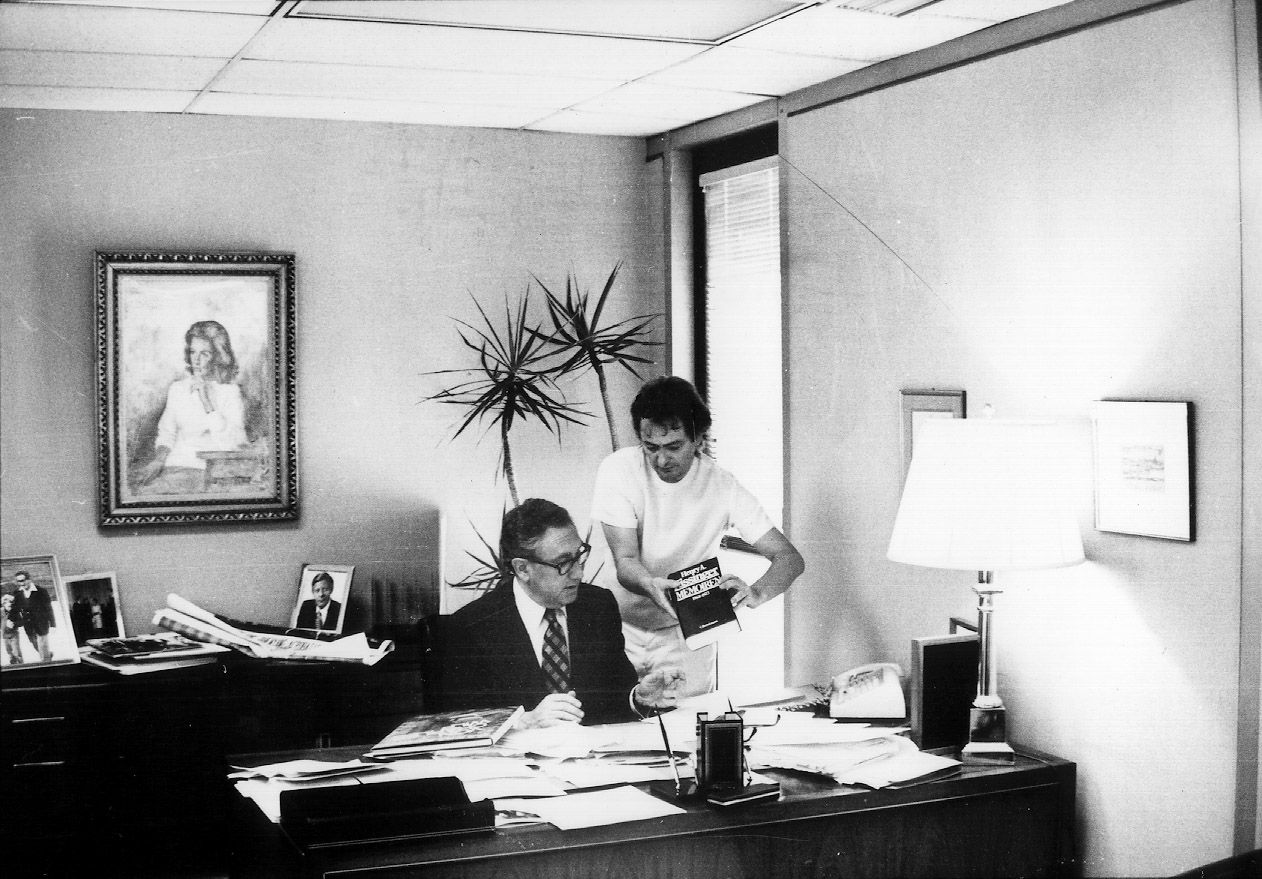
(Picture: atatak.com)
And according to Ammann Kissinger indeed was most impressed (see: Jean-Christoph Ammann, Bei näherer Betrachtung, p. 57). – But what exactly did Ammann say to his famous (and famously intelligent) visitor (probably in 1994, when On Kawara was being exhibited at Frankfurt)? An annotation is referring to the On Kawara essay, beginning at p. 87. And paraphrasing this very essay I would imagine that Ammann must have explained to Kissinger that On Kawara shifted, with the date paintings, his or our attention from the categories of our daily life to the most fundamental categories of time and space. Doing such a painting meant, or means, to shift one’s conscience’s focus, if we are a politician, from the daily affairs of a politician to the most fundamental categories that, if we are reminded of these categories, make us feel small, but also – possibly – desperate, or possibly: contemplative (instead of: active).
And it is not only to contemplate the notions of time and space (time, by the way, being directed towards the future, but space, being a space of possibilities to move in, as On Kawara was a traveller), but also about the notions of order (the organisation of time by a calendar, for example) and chaos, the chaos of daily life, or of that particular day’s chaos a date painting is being made (and that is also alluded to by newspaper clippings that are given to or associated with these paintings). The individual chaos of an individual mind, or the individual and political and collective chaos that an individual mind has to navigate through, being directed to the order of our calendar and being directed to the more fundamental categories, more fundamental than categories of politics (and of everyday life).
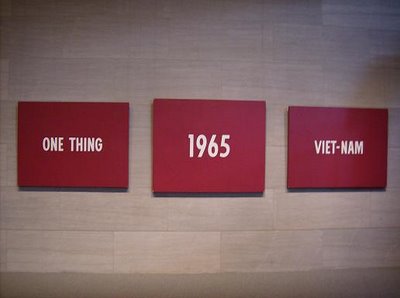
(Picture: curate.tumblr.com)
Of course I do not know what exactly Ammann did say to Kissinger. But two things from Ammann’s account do strike me as noteworthy as well. First of all: According to Ammann Kissinger was that impressed by the explanations of his guide that he demanded to see something that he, Kissinger, could not do ›himself‹. And one might interpret this as an ironically taking refuge in works of art that one can simply admire for craftmanship, and that not do invite or force us to shift our categories of everyday’s life to the most fundamental ones.
Because, secondly, Ammann does also say in his On Kawara essay that, if he would own such a date painting, he would, and this every evening, make the contemplation of such a painting a contemplation of God, the world and the universe. But why not doing so? Only for not owning one? Well, why is Ammann saying if? And: that he would?
MICROSTORY OF ART
ONLINE JOURNAL FOR ART, CONNOISSEURSHIP AND CULTURAL JOURNALISM
HOME
Bruce Nauman
Today Painting II –
Bruce Nauman
(Picture: artobserved.com)
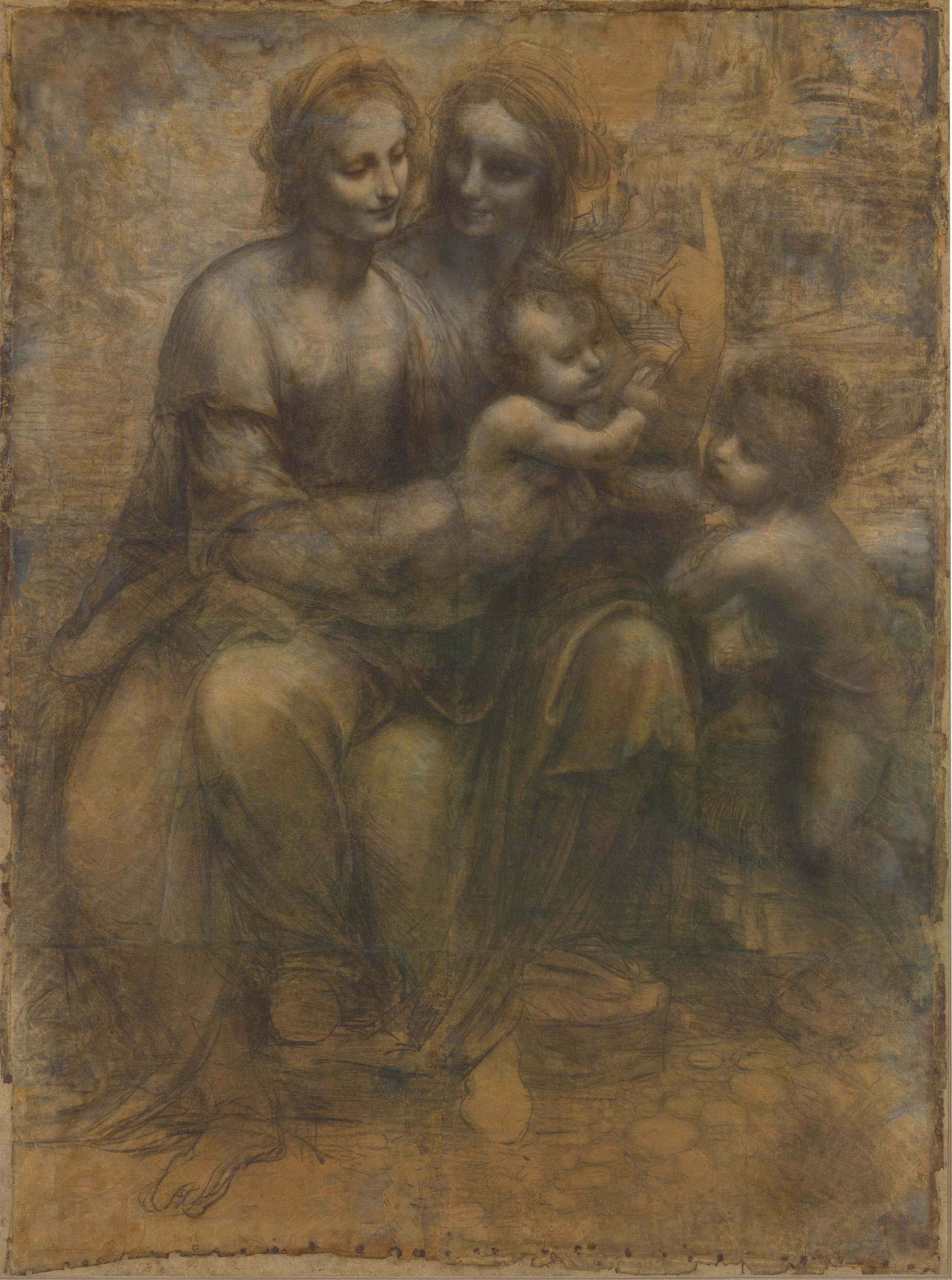
With this snippet, dedicated to US artist Bruce Nauman, we keep on having a focus on a particular fruitful moment that one can have with art, and we keep on having a focus on dealing with interesting ways of looking at art. But henceforth it is about ›Today Paintings‹ in a less literal sense. And with Bruce Nauman it is, maybe surprisingly, not even about a painting in the first place, even if it is about the quintessential Old Master, about Leonardo da Vinci, and about Leonardo as being a very particular and most fundamental force and inspiration in the life of artist Bruce Nauman, one of the godfathers of contemporary art. It is about the one moment that Nauman had with Leonardo, about Nauman’s ›Today Painting‹ as it were, respectively large drawing, and about this very moment’s implications and consequences.
It is obvious that some of the godfathers of contemporary art took their, or some inspiration from Leonardo. It is obvious with Andy Warhol, who was, maybe, less concerned with Leonardo’s actual work than with his fame and cultural meaning. And it is obvious with Joseph Beuys who, after the rediscovery of the Codices Madrid in 1966, experimented with a combining of text and drawing, as if to emulate or as if to experiment with ways to express and to practice holistic thinking, inspired by Leonardo’s notes, notes scattered with drawings.
Least of all it is obvious with Bruce Nauman (http://en.wikipedia.org/wiki/Bruce_Nauman). And if the artist had not revealed himself the meaning that Leonardo da Vinci had had, and still had in his life (I read about this in a 2004 interview that was published in the German weekly Die Zeit), we would probably know very little or even nothing about it, since it is not obvious from Nauman’s work.
At best art would, Nauman said in that interview, at best art would be capable of shifting something in a human individual, and no, art was not at all about redemption, but about a certain energy, a certain affecting energy, as I do understand Nauman. And asked if art had shifted something in him as an individual, Nauman answered that yes, but actually only once: namely when seeing in 1968 Leonardo’s Burlington House cartoon (http://en.wikipedia.org/wiki/The_Virgin_and_Child_with_St_Anne_and_St_John_the_Baptist), as displayed in a darkened cabinet in the National Gallery of London (which had bought the cartoon only in 1962), he felt that something had been shifted, although he, Nauman, could not even say what exactly it was, that had deeply affected and moved him, and led him to visit the cartoon whenever being in London.
*

(Picture: whitehotmagazine.com)
Thinking about this retrospection of an artist to the year of 1968 (when Nauman was 27 years old), I am thinking now back to a visit to Berlin, a couple of years ago, in 2011, when I not only had the chance to see Nauman’s architectural sculpture Room with My Soul Left Out/Room That Does Not Care in the Hamburger Bahnhof, but also works of Leonardo in the Gesichter der Renaissance Ausstellung in the Bodemuseum at the Museumsinsel. Two experiences that had to do with darkened rooms, since also the rooms of the Bodemuseum were darkened, while the pictures and sculptures in that show were carefully lit individually.
And thinking back to what Nauman said in that 2004 interview, it seems to me now, that his Room, that I would name an experiment of coldness that evokes imaginations of incarceration or being in a spaceship, reflects the experience that Nauman had with Leonardo ex negativo. Since the Room, made of two horizontally intersecting corridors plus one vertically intersecting corridor, and only being lit with some spare lights, is deprived of everything that makes space warm and appealing for human beings to live in, and this Room That Does Not Care for human soul, is, of course, also deprived of pictures (except for those mental pictures that a visitor might bring into these corridors). Deprived of pictures that might shift something in a human soul, and if picture potentially can do this, any room wherein such pictures were placed, in consequence would become rooms that do care for human souls. This is what I mean by saying that a work of art seems to reflect a (positive, a most wonderful, astonishing) experience ex negativo, and this is also a meaningful mental image to bring into these corridors when visiting them: thinking of Bruce Nauman, as being most deeply affected by Leonardo. Fundamental things might become more clear in consequence. In brief: The Leonardo experience of 1968, in my view, found and finds a meaningful counterpart in the experiment of coldness that Nauman placed with the rebuilding of his Room sculpture in the Hamburger Bahnhof of Berlin. And in reflecting both statements, one verbal, one being an architectural sculpture, it is becoming more clear, at least for me, what Nauman’s art is all about and how it works.
*
The Gesichter der Renaissance exhibition did, I believe, not ›shift‹ something in me, and who does want to contemplate a work by Leonardo, if being part of a large crowd and while also having to stare at a security man, placed beside the actual work. Memories of darkened rooms remain, and also memories of visiting, reluctantly, Nauman’s Room in the Hamburger Bahnhof. But I am realising now more clearly how these two experiences might relate to each other, more clearly than I was capable to realise it then. And more than ever I have become curious in what ways art might shift something in human individuals. Which is why we continue these series of snippets with a Bruce Nauman snippet, and if one likes so, one might call this a shifting as well, or: a late and retrospective examining of a shifting, triggered by a work by Nauman, and triggered by the thinking of Nauman’s moment with Leonardo.
MICROSTORY OF ART
ONLINE JOURNAL FOR ART, CONNOISSEURSHIP AND CULTURAL JOURNALISM
HOME
Painter Man
Today Painting III –
Painter Man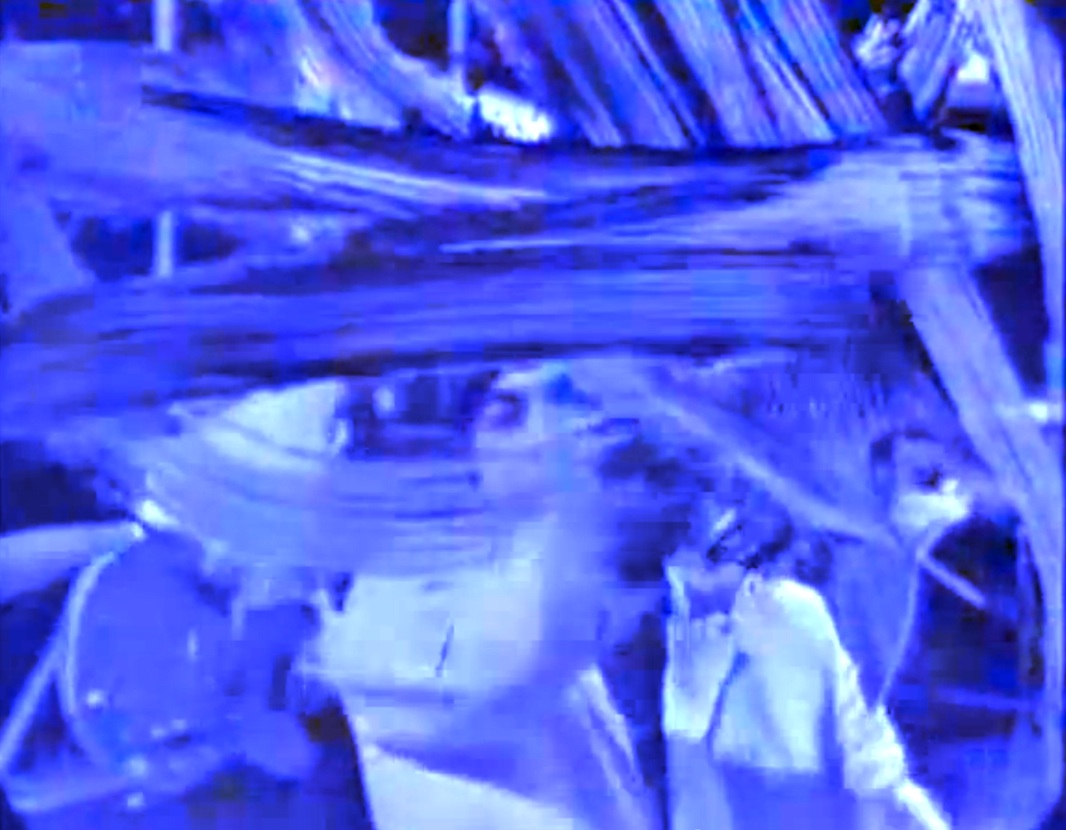
(Picture: youtube.com/DS)
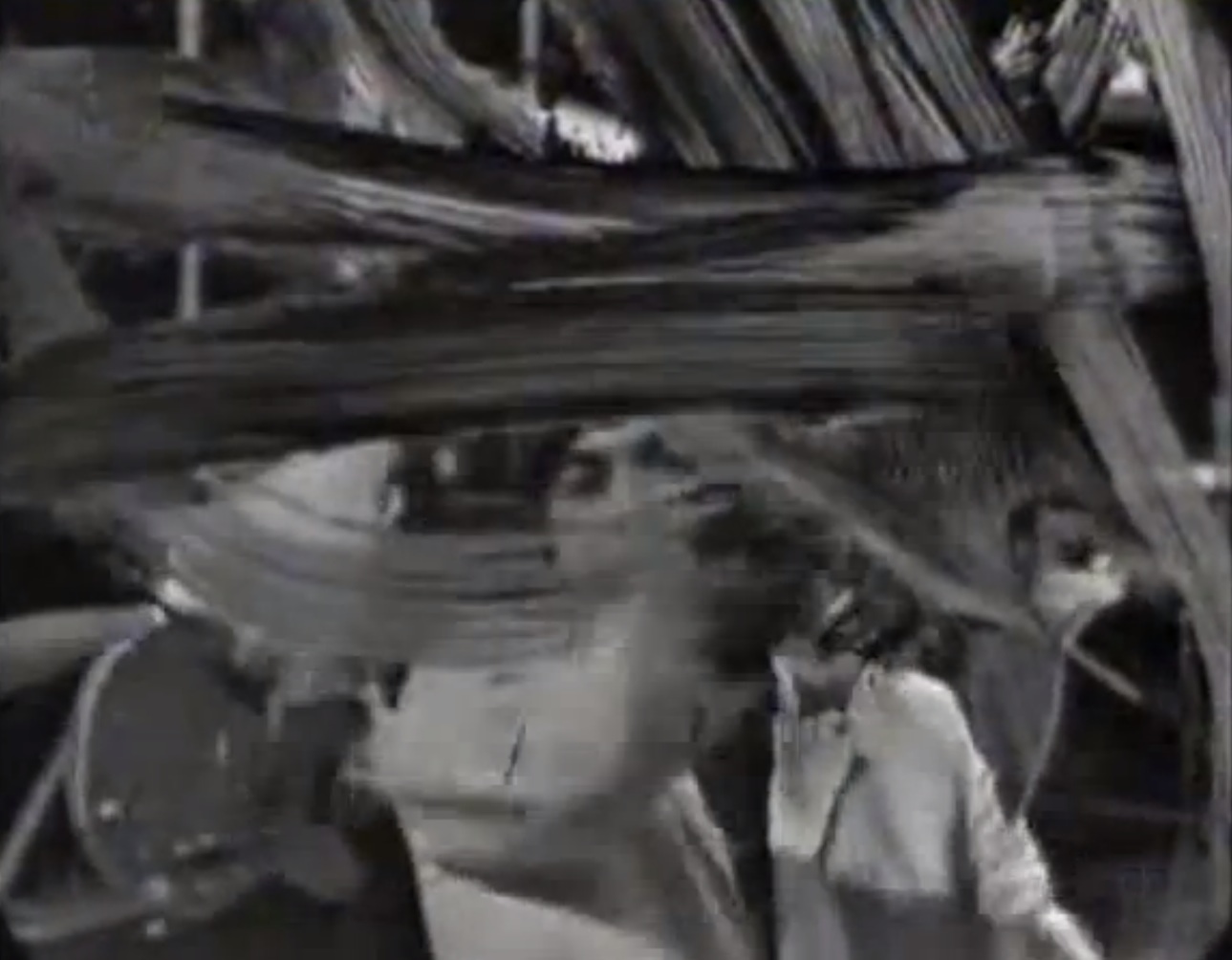
(Picture: youtube.com)
Our next ›Today Painting‹ is – well, it is a song. A song? How boring, how old-fashioned. Don’t we live in the age of the track?
Exactly. This is it what it might have sounded like, back then, as well. And with ›back then‹ we mean the 1960ies. A painting? How boring, how old-fashioned. Don’t we live in the age of TV, of conceptual art? Hasn’t painting come to its end? Or with the words of our very song ( https://www.youtube.com/watch?v=mmxMqV00cUE): »Tried cartoons and comic books / Dirty postcards could have done / Here was where the money laid / Classic art has had it’s day« (source: metrolyrics.com).
And from a today’s perspective one might say: this is exactly how one, how they kept painting alive – by choreographing, as it were, a complicated dance around the good old old-fashioned easel painting (and by the way: this is how to keep the song alive, the 2 and a half minutes classic pop song, with verse, bridge and refrain, and fascinating in its artful banality, even in the age of the track).
It is, indeed, a classic pop song, our well-chosen song Painter Man of 1967 (http://en.wikipedia.org/wiki/Painter_Man), fascinating in its artful banality, almost a folk song, a possible hymn, if one may say so, of the ›end of painting‹ movement. And this is the form that the band named The Creation had obviously chosen also to celebrate the good old old-fashioned painting. How often must the singer have repeated this anti-establishment gesture of painting on a glass (our actual today painting, here), emulating a camera lens or the actual TV screen. Think this image as being painted by Gerhard Richter, and it turns from a ›Today Painting‹ into a painting of today. And speaking of this kind of artful magic trick: art forger Wolfgang Beltracchi (http://en.wikipedia.org/wiki/Wolfgang_Beltracchi), in his memoirs (with Helene Beltracchi), does refer to this very song (which is actually why we have chosen to come back to it here), a song that, among other things, appears to have inspired Beltracchi in finding his own complicated dance steps. Around the good old old-fashioned painting (original), done by whosoever. And also the art of forging has its complicated parallel story, one might say: since it includes the good old old-fashioned naive ›cover‹ that does simply aim at a repeating, towards the pastiche, the imaginary painting, artfully inserted into the oeuvre catalogue of good old old-fashioned painters (as we have just inserted Painter Man into the oeuvre of Gerhard Richter; see small picture above on left; but at least we are transparent in giving a provenance here).
MICROSTORY OF ART
ONLINE JOURNAL FOR ART, CONNOISSEURSHIP AND CULTURAL JOURNALISM
HOME
John Lennon
Today Painting IV –
John Lennon
(Picture: pinterest.com)
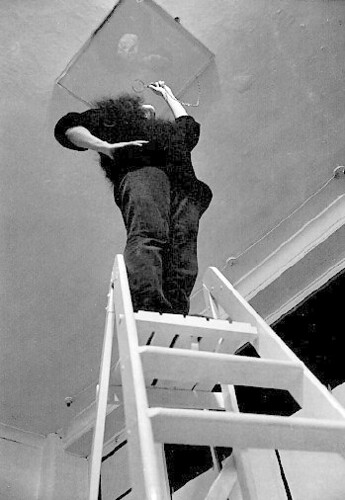
(Picture: flickr.com)
If I had written this column in my youth, I would have described as John Lennon’s ›today painting‹ the card that Yoko Ono presented him with, when they first met, in 1966, a card that simply stated ›Breathe‹.
Upon which John Lennon made something like a pant, asking ›like this?‹. But this I came to know only recently. Like the rest of the actual story of how the met, fell in love and came together (various accounts can be read here: http://entertainment.howstuffworks.com/john-lennon30.htm and http://www.beatlesbible.com/1966/11/07/john-lennon-meets-yoko-ono). At least according to their later accounts.
And the full story actually goes on after the panting (which I did not know in my youth), since it was apparently the Ceiling Painting by Yoko Ono that made the most profound impression on him. That had him climb up a latter and look through a spyglass – to read the one word ›yes‹.
And this, long before The Creation came out with their song Painter Man, made Lennon apparently turn away from anti-establishment gestures that simply said ›no‹ to everything. Without exactly knowing what to affirm. This is what caused him to turn away from, or at least to question a just negative anti-establishment attitude: a painting, a ›yes‹, a love affair, and, yes, why not?, conceptual art.
In 1980 John Lennon was shot. And 34 years later, his widow published her conceptual work Tokyo Sky in the German art journal art – Das Kunstmagazin and also on Twitter. A tiny round dot of blue sky (not without clouds), and in the middle of a blank page, blank except for the written invitation to spread the dot’s blue over the page into a sky coming from one’s heart. A do-it-yourself work of art, meant maybe for every day, including today, and with this we do recall both, the Ceiling Painting and Tokyo Sky, not to forget the history, the time span between these two dates. Between (probably) 7 November 1966 and, well, let’s take as a date of Tokyo Sky the date of Yoko Ono’s twittering of this work of art: 15. September 2014 (https://twitter.com/yokoono/status/511544286249488384).

(Picture: twitter.com)
MICROSTORY OF ART
ONLINE JOURNAL FOR ART, CONNOISSEURSHIP AND CULTURAL JOURNALISM
HOME
Werner Herzog
Today Painting V –
Werner Herzog
(Picture: pinterest.com)

(Picture: toutlecine.com)
The central image of filmmaker Werner Herzog’s Fitzcarraldo (http://en.wikipedia.org/wiki/Fitzcarraldo) is, as of course everyone knows, the image (or sequence) of a ship being pulled over a mountain. And one might also say that, because Herzog dismissed the suggestion to produce only the illusion of a steamer, a model steamer, standing for a real steamer, being pulled over a mountain, that this was about a performance. About a happening, and not just about an image. It had to be done, unless the image might have been seen only as being pretentious, even if one might also imagine a ballad, a poem, containing such an image. But here: the vision had, on a level of reality and at least as to its central image, to be realized.
And since the central image of a ship being pulled over a mountain is such a strong image, one might easily forget that this central image of, let’s say, surmounting gravity, surmounting any kind of inertia, does not stand for itself within the movie Fitzcarraldo (the seemingly absurd, by the way, within the vision of Fitzcarraldo, does make perfect sense and is not being staged to conquer absurdity at all), and it does not stand for itself within the conglomerate of all the narratives that, today, are associated with the movie Fitzcarraldo, with a filmmaker’s vision, upon which his movie was based, and also with this very filmmaker’s writings. Other images do work as counterpoints to the one central image, other images juxtapose this one strong and central image, and one might also say that this is necessary to bring out the quality of this one central image.
What images could be juxtaposed to the one central image? For example the image of a filmmaker and his cameraman Thomas Mauch waiting for a certain light. Because what would be more humble than waiting for a particular light to come? And what would be more opposed to boldly challenging gravity and challenging sense with having a steamer being pulled over a mountain than: being humble and just to wait?
If the image of a ship being pulled over a mountain is something reminding of Sisyphus (http://en.wikipedia.org/wiki/Sisyphus) getting his work actually done, of freeing himself of a burden, because the gods did not mean that his task could actually ever be fulfilled, while this central image is about something bold, this very image of boldness (if not to say: hubris) can thus be juxtaposed with images of humility. Also taken from the mythic narratives that today make the whole myth of Fitzcarraldo, namely here the Les Blank documentary The Burden of Dreams (http://en.wikipedia.org/wiki/Burden_of_Dreams) about the making of Fitzcarraldo.
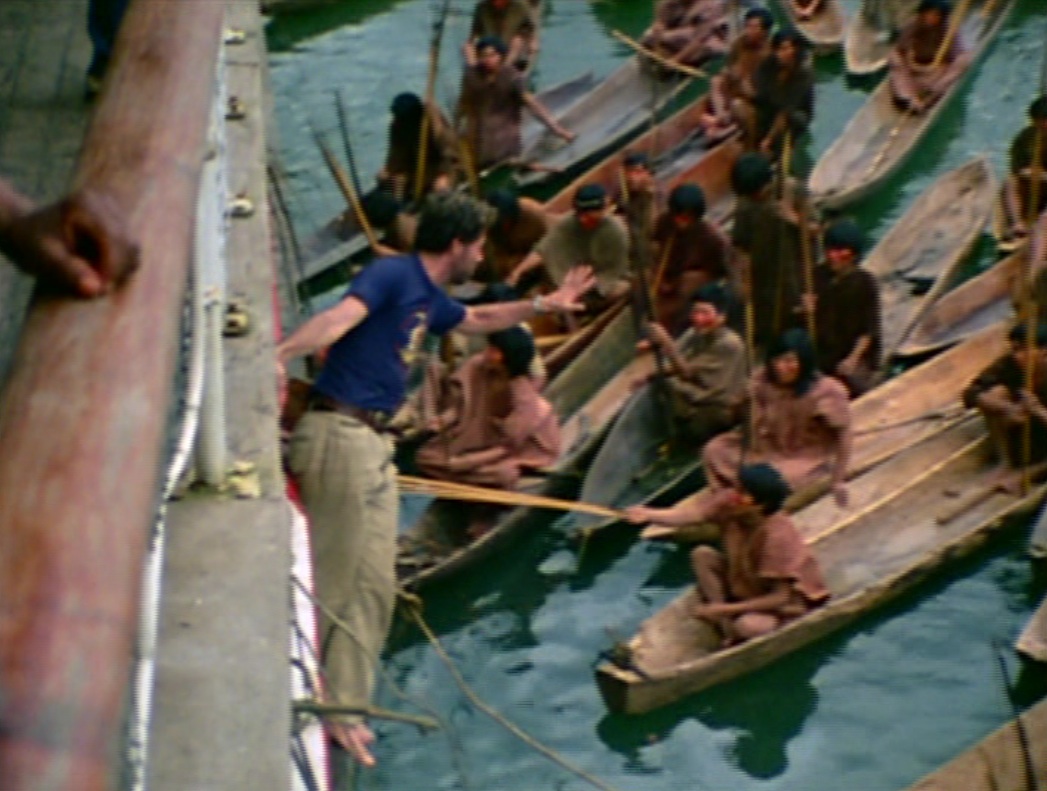
(Picture: The Burden of Dreams)
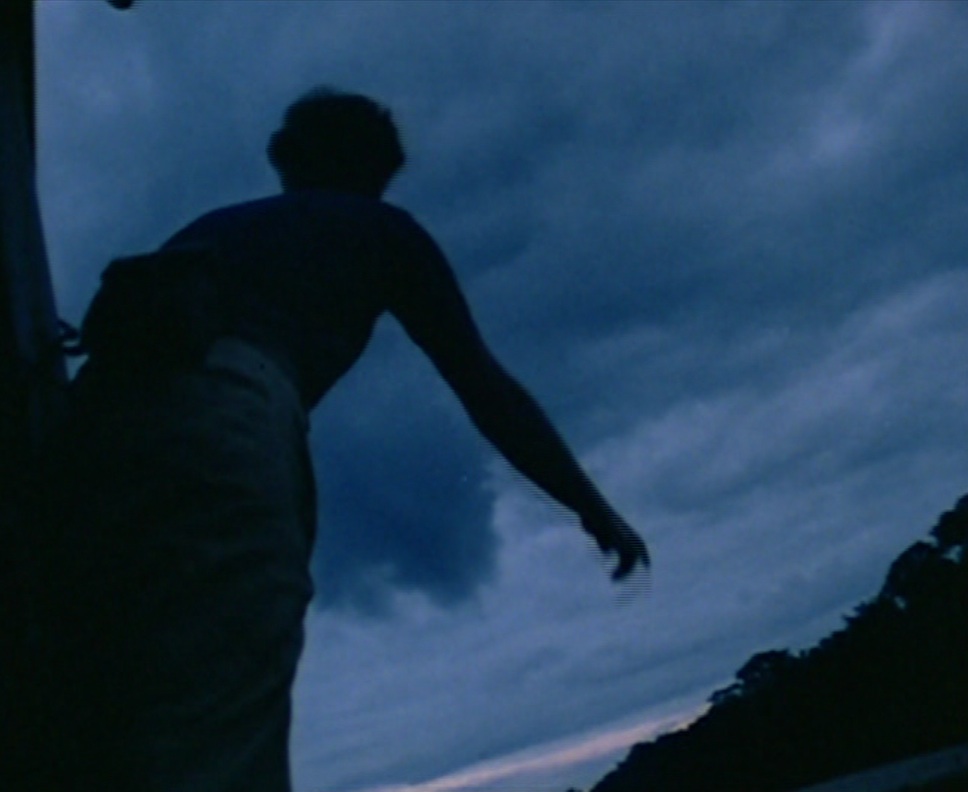
(Picture: The Burden of Dreams)
Here, in one sequence, Werner Herzog and his team are said to wait for the particular light of the here so-called ›magic-hour‹ at the end of a day, to bring the particularly golden light of the ›magic hour‹ into the film. And here, although a ship might be pulled in the end over a mountain, here is nothing but waiting for the team. For the particular golden light to come or not, for the day or the day’s dawning to allow the shooting of a particular film scene or not. Hence this is about a ›today painting‹, ›painting‹ referring also to the tableau-like quality of certain very immobile images that Herzog likes to have in his films, a ›today painting‹ that, however, nature has to be inclined to help the filmmakers to paint. And this short sequence from The Burden of Dreams shows Werner Herzog and his team also working into what I would call the ›blue hour‹.
Be this, thus, also a supplement to the essay on Titian, Leonardo and the Blue Hour (http://www.seybold.ch/Dietrich/TitianLeonardoAndTheBlueHour), and we might also regard this little sequence as a find to be included into a future cultural history of the blue hour.
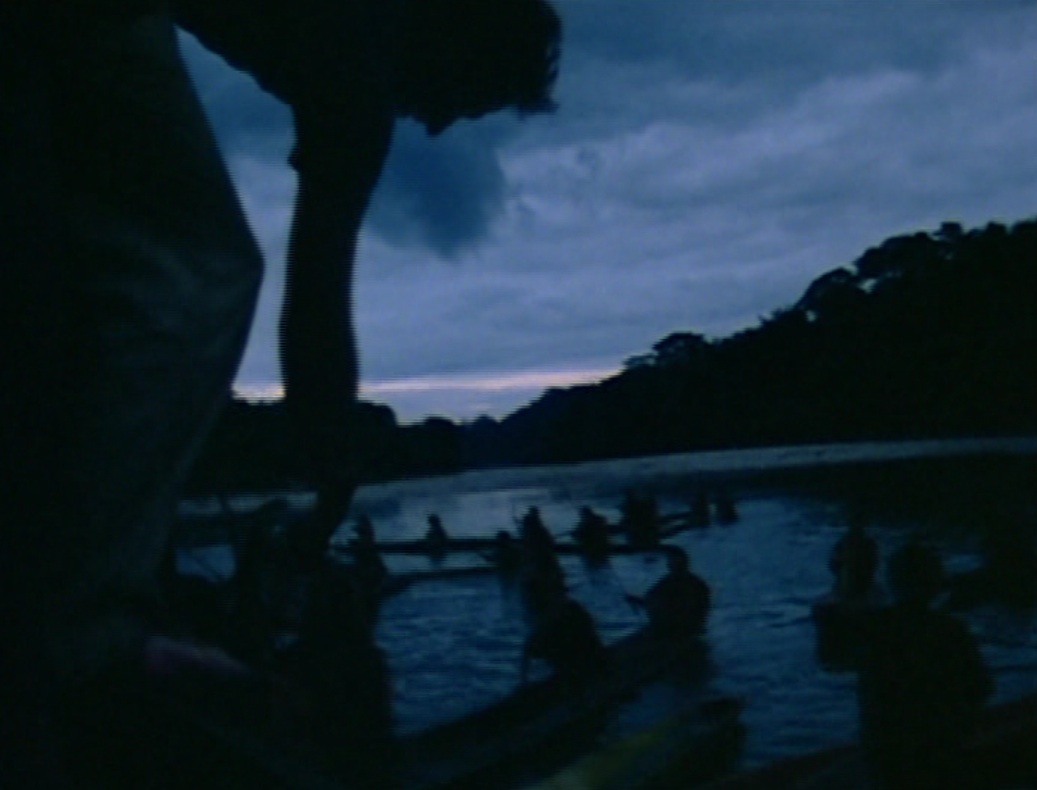
Werner Herzog and his team working into the blue hour (picture: The Burden of Dreams)
MICROSTORY OF ART
ONLINE JOURNAL FOR ART, CONNOISSEURSHIP AND CULTURAL JOURNALISM
HOME
| MICROSTORY OF ART ONLINE JOURNAL FOR ART, CONNOISSEURSHIP AND CULTURAL JOURNALISM TODAY PAINTING 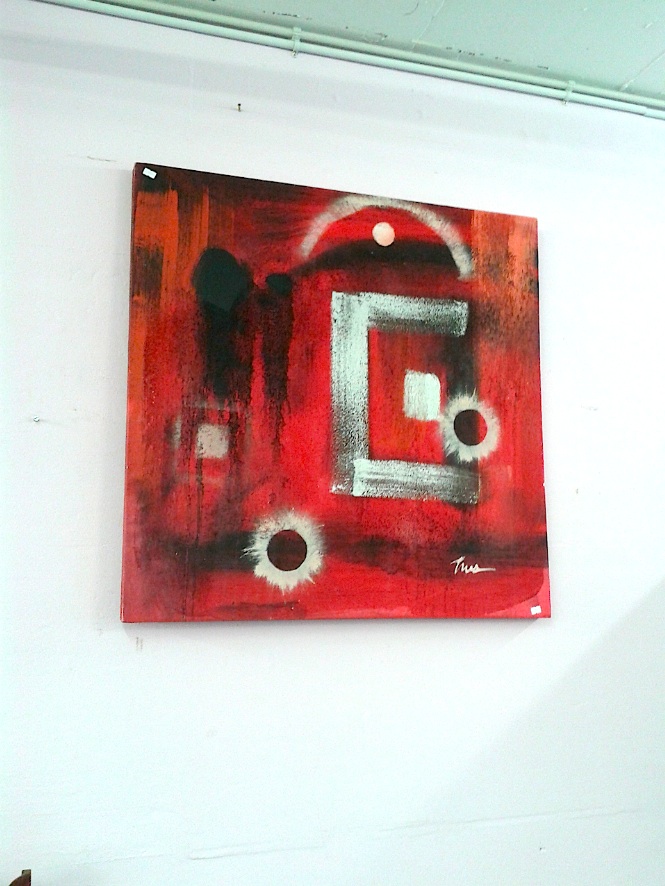 Portrait of…? Portrait of…?  (Picture: DS; starwars.wikia.com) |
| MICROSTORY OF ART ONLINE JOURNAL FOR ART, CONNOISSEURSHIP AND CULTURAL JOURNALISM TODAY PAINTING (Picture: DS/Peter Doig: Swamped) |
© DS